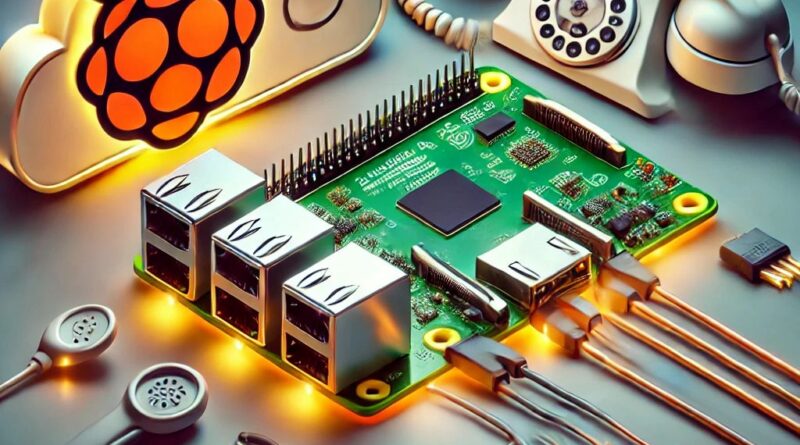Raspberry Pi as a PBX: A Tiny Powerhouse for Communication
In an era where communication technology is evolving rapidly, staying connected without breaking the bank is crucial. Enter the Raspberry Pi, a credit-card-sized computer that has found its way into homes, industries, and now even offices. While the Raspberry Pi is famous for DIY projects like home automation, one of its most impressive applications is serving as a Private Branch Exchange (PBX) system. A Raspberry Pi-powered PBX offers businesses a cost-effective, open-source alternative to expensive commercial systems. But what does that setup look like? And is it viable? Let’s dive in.
What is PBX, and Why Does It Matter?
A PBX is essentially the brain of a business’s phone network. It routes incoming and outgoing calls, handles internal extensions, manages voicemail, and even supports advanced features like automated attendants (IVR) and call conferencing. Traditional PBX systems, however, are often expensive and complex to maintain. With the rise of Voice over IP (VoIP) technology, PBX systems have shifted from bulky hardware to flexible software solutions.
This is where the Raspberry Pi shines. The low cost, power efficiency, and reliability of the Raspberry Pi make it a surprisingly good candidate for running a PBX system with open-source software like Asterisk, with FreePBX serving as its web-based graphical user interface and configuration editor.
Why Use a Raspberry Pi for PBX?
Low Cost:
A complete Raspberry Pi kit (with a case, SD card, and power supply) costs around $50-$100, compared to thousands for commercial PBX hardware.
Energy Efficient:
Traditional PBX systems can be power-hungry, but a Raspberry Pi consumes less than 5 watts, leading to substantial energy savings.
Compact & Portable:
The tiny form factor makes it easy to install in tight spaces or carry around for quick setups.
Open-Source Flexibility:
By running open-source software, you get full control over your system, eliminating the need for proprietary licenses.
Scalability:
Although it’s small, the Raspberry Pi can handle a modest office’s communication needs. It’s suitable for up to 10-20 simultaneous calls, depending on network and hardware configuration.
We’ve collected a few case studies of just what Raspberry Pi’s call capacity actually is:
1. Innovate Asterisk’s, Conrad De Wet’s video (https://www.innovateasterisk.com/s1e8-how-many-calls-on-raspberry-pi-with-asterisk-pbx/) comes up as the most thorough test we could source on the net. His findings, discussed in Season 1, Episode 8 on the Innovate Asterisk site, indicate that both the Raspberry Pi 3B+ and the Raspberry Pi 4B were tested under different conditions. These tests involved both pass-through calls (where no audio transcoding is required) and transcoded calls (which are more CPU-intensive). The Pi’s limits for the 3B were roughly 150 calls before transcoding and 30 calls with transcoding, and the Pi’s limits for the 4B were roughly 250 calls pre-transcoding and 70 calls with transcoding.
Similar tests conducted on the concurrent call-handling capacity of Raspberry Pi devices using Asterisk PBX. Include the following:
2. Raspberry Pi with VitalPBX: In tests conducted by VitalPBX (https://vitalpbx.com/blog/concurrent-call-capacity-vitalpbx/), the Raspberry Pi 4 was capable of handling up to 100 concurrent calls, even with call recording enabled. This suggests that the Pi 4, with its 4GB of RAM, is well-suited for small-to-medium-sized setups where budget constraints are essential without compromising call quality. The system used a low-cost setup (under $100) and demonstrated the potential of the Pi for handling robust PBX tasks in small business environments. Learn more here: https://vitalpbx.com.
3. RasPBX with Asterisk on Raspberry Pi: An experiment shared on SourceForge detailed the use of RasPBX (Asterisk for Raspberry Pi). In real-world conditions, a Raspberry Pi managed 9-11 concurrent VoIP calls without noticeable degradation in voice quality, as long as transcoding was avoided. CPU usage remained relatively low at 5% per call, but the system began to show quality issues beyond 10 calls, even though resource utilization didn’t peak. This demonstrates the limits of Raspberry Pi for small setups where higher concurrency isn’t critical.
4. Twilio SIP Trunking with Raspberry Pi: Another experiment involved running the 3CX PBX software on a Raspberry Pi 4 connected to a Twilio SIP trunk. This setup aimed to test the feasibility of using a lightweight, low-cost PBX solution with modern telephony features. While no exact limit on call handling was reported, this configuration illustrated the practical potential of the Pi for both home and small business phone systems, emphasizing simplicity and scalability for lower call volumes.
A forum worth looking at for more findings on the subject is: https://www.voip-info.org/forum/threads/how-many-endpoints.25373/
These experiments demonstrate that while Raspberry Pi is not suitable for enterprise-level call handling, it excels in smaller-scale scenarios such as home offices or small businesses, with the ability to manage 10-100 calls depending on setup and resource optimization. Also, Real-world use may cause additional load, as having more users on the same system would add load to other parts of the system causing more load. These tests show the amazing power that these devices have, but in truth you should perform you own test before relying too heavily on any other findings, given the uniqueness of each situation.
The results suggest that Raspberry Pi devices, particularly the 4B, can handle a reasonable volume of simultaneous calls, but the specific capacity depends heavily on whether the calls require transcoding. Pass-through calls are significantly less demanding and allow for more concurrent connections, while transcoded calls reduce the number of calls that can be managed effectively without impacting performance.
This exploration highlights that Raspberry Pi, although not as powerful as traditional servers, can still serve as an efficient and cost-effective platform for lightweight PBX setups. You can explore more details and watch the video on their official page for additional insights on the test setup and findings.
Setting up a Raspberry Pi PBX System
Here’s a quick overview of how you can turn a Raspberry Pi into a fully functioning PBX system.
Choose Your Raspberry Pi Model:
The Raspberry Pi 4 is ideal, with 2-8GB of RAM and Gigabit Ethernet.
A reliable microSD card (32GB or more) is recommended for storage. Alternatively, you can use a USB SSD for improved reliability.
Install an OS:
Start with Raspberry Pi OS Lite, a minimal operating system that leaves more room for the PBX software.
Install Asterisk or FreePBX:
Asterisk is a highly customizable PBX solution but requires technical know-how.
FreePBX offers a user-friendly web interface, making it easier for beginners to manage the PBX system.
Both can be installed directly on the Raspberry Pi via terminal commands.
Configure SIP Extensions:
You’ll need to configure SIP accounts for each phone or softphone in your network. This allows them to register with your PBX and make internal or external calls.
Connect to a VoIP Provider:
To make and receive external calls, you’ll need a VoIP trunk from a provider, which links your PBX to the public telephone network.
Setup IVR and Voicemail:
Customize your PBX to include voicemail, call queues, and automated attendants to route calls efficiently.
Test the System:
Make test calls between extensions and to external numbers to ensure everything works seamlessly.
Real-World Use Cases
Small Businesses:
A Raspberry Pi PBX can serve as the main communication system for small offices with fewer than 20 employees. It handles internal calls, call forwarding, and voicemail efficiently.
Home Offices:
With remote work becoming the norm, a PBX at home can make managing work calls simple and professional. Features like caller ID routing ensure important business calls are never missed.
Event Management:
Event organizers can set up temporary communication systems at venues with multiple extensions to coordinate on-site operations.
Educational Institutions:
Schools and universities can use a Raspberry Pi PBX to manage communication between classrooms, administrative offices, and security teams.
Performance Considerations
While the Raspberry Pi can handle PBX tasks well, there are a few things to keep in mind:
Limited Call Volume: A Raspberry Pi 4 can manage 10-20 simultaneous calls, but larger call volumes may cause performance issues.
Network Dependence: Since most PBX functions rely on VoIP, a stable internet connection is critical for reliable communication.
Backup Power: Adding a UPS (Uninterruptible Power Supply) ensures the PBX system stays online during power outages.
The Verdict: Punching Above Its Weight
The idea of using a Raspberry Pi as a PBX system might sound unconventional, but it’s both practical and cost-effective. For small businesses and DIY enthusiasts, it offers the perfect blend of affordability, functionality, and flexibility. Although it’s not suitable for enterprises with hundreds of users, the Raspberry Pi PBX can serve as a reliable communication hub for small offices, remote teams, and even educational institutions.
In a world where innovation often comes with a hefty price tag, the Raspberry Pi proves that big things can come in small packages. With a bit of technical know-how, anyone can create a professional-grade PBX system at a fraction of the cost of commercial solutions.
So, if you’re looking for an affordable way to streamline your communication setup, why not give the Raspberry Pi PBX a try? You might just be surprised by what this little computer can do.



